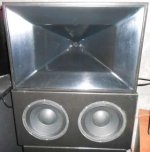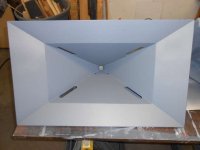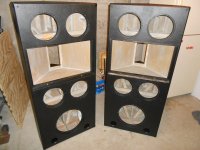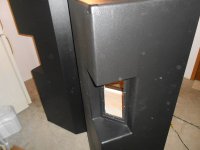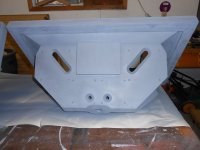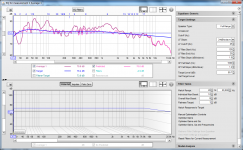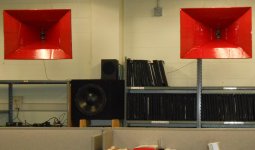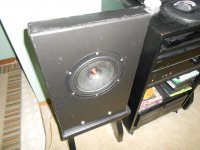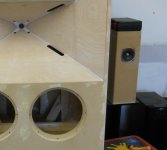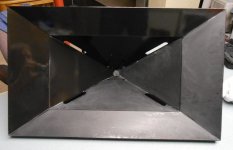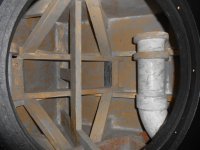Hi all,
After being an observer so long on this site, Its time to post something on my current project. I previously have built many types of speakers over the years which led me down the path of trying different designs like open baffle and Unity/Synergy horns. Last year I built a 60X90 Unity horn which I designed using Bill Waslo's excellent spreadsheet. I am very impressed with the results. Here is a list of the hardware in these:
PRV Audio D290Py-B 1" Polyimide Horn Compression Driver
GRS 5SBM-8 5" Sealed Back Midrange (4 per horn)
Neutrik Speakon 4 pole interconnects for horns, 2 pole for low mids and subs
MiniDSP 4x10hd (digital crossover)
(1) SURE 4 channel 100 watt class d board, 36 volt power supply (for horns)
(2) SURE 2 channel 300 watt class d boards, 48 volt power supplies (for low mids and subs)
Neutrik Color coded interconnects (to be made)
4 10" Dayton pro woofers in sealed enclosures (low mids)
Using some ported 8" Dayton reference woofers as subs right now until the new cabinets are completed.
The success of this speaker has made me determined to build a larger one with added
woofers and sub.
I designed the enclosures to fit the existing Unity horns, but halfway through building them I decided to build some new horns to fit inside the cabinets, which will include 6.5" woofers.
I plan on posting some updates as these come together.
-Nate
After being an observer so long on this site, Its time to post something on my current project. I previously have built many types of speakers over the years which led me down the path of trying different designs like open baffle and Unity/Synergy horns. Last year I built a 60X90 Unity horn which I designed using Bill Waslo's excellent spreadsheet. I am very impressed with the results. Here is a list of the hardware in these:
PRV Audio D290Py-B 1" Polyimide Horn Compression Driver
GRS 5SBM-8 5" Sealed Back Midrange (4 per horn)
Neutrik Speakon 4 pole interconnects for horns, 2 pole for low mids and subs
MiniDSP 4x10hd (digital crossover)
(1) SURE 4 channel 100 watt class d board, 36 volt power supply (for horns)
(2) SURE 2 channel 300 watt class d boards, 48 volt power supplies (for low mids and subs)
Neutrik Color coded interconnects (to be made)
4 10" Dayton pro woofers in sealed enclosures (low mids)
Using some ported 8" Dayton reference woofers as subs right now until the new cabinets are completed.
The success of this speaker has made me determined to build a larger one with added
woofers and sub.
I designed the enclosures to fit the existing Unity horns, but halfway through building them I decided to build some new horns to fit inside the cabinets, which will include 6.5" woofers.
I plan on posting some updates as these come together.
-Nate
Attachments
Also, I found a way to get the 5" mids closer into the apex of the horn by cutting the steel frame down from circular to a square shape, leaving room for a gasket. This should allow the crossover point higher around 1.2-1.5k. The unity horn I previously built I could not get much output past 1k, probably due to the placement/spacing of the ports. The new horn they are spaced closer in. The material is 1/2" plywood, which reduces the volume behind the port from the other horns 3/4" thickness.
I have been working on these on and off for the past six months. I drastically underestimated the time needed to build the woofer enclosures, thinking originally a few weeks I could bang them out. I wanted to make sure that they were rigid with sufficient bracing, which took quite some time to complete.
The horn enclosure has a smaller volume than the woofer enclosures as the 6.5" woofers don't need much back volume (I'll have to experiment with this). I filled the dead space in the back of the horn enclosure walls with cat litter, a little over two buckets full. This drastically reduced the wall resonance. I also used a gallon of AcoustX sound absorption paint in the interior. From what I can tell thus far this really works do deaden the insides of the enclosures. If you use AcoustX paint be careful not to get it on your hands, its really difficult to wash off!
The 2x10 enclosures are 2 cu ft. sealed each and the sub is 4 cu ft. ported with 2 3"x18" ports. I have a pair of Eclipse 15" (similar to TC Sounds drivers) I plan on using.
The exterior is painted with DuraTex.
The horn enclosure has a smaller volume than the woofer enclosures as the 6.5" woofers don't need much back volume (I'll have to experiment with this). I filled the dead space in the back of the horn enclosure walls with cat litter, a little over two buckets full. This drastically reduced the wall resonance. I also used a gallon of AcoustX sound absorption paint in the interior. From what I can tell thus far this really works do deaden the insides of the enclosures. If you use AcoustX paint be careful not to get it on your hands, its really difficult to wash off!
The 2x10 enclosures are 2 cu ft. sealed each and the sub is 4 cu ft. ported with 2 3"x18" ports. I have a pair of Eclipse 15" (similar to TC Sounds drivers) I plan on using.
The exterior is painted with DuraTex.
Once I install the 6.5" midwoofers into the horn section, I have a dilemma on if I need to purchase another amplifier and add an additional crossover. I have a JBL three way which could be used to split the low out from the miniDSP into the low/low mid channels. I am not sure how the 300w sure amp could drive four Dayton Pro 10" drivers per channel at 8 ohms (series/parallel) as it would reduce the power per driver to around 35 watts, although these are fairly efficient so this might work for now.
Here is where I plan the crossover points:
1400hz high/mid
300hz mid/midwoofer
120hz midwoofer/woofer
60hz woofer/sub
Any suggestions/thoughts?
Here is where I plan the crossover points:
1400hz high/mid
300hz mid/midwoofer
120hz midwoofer/woofer
60hz woofer/sub
Any suggestions/thoughts?
Once I install the 6.5" midwoofers into the horn section, I have a dilemma on if I need to purchase another amplifier and add an additional crossover. I have a JBL three way which could be used to split the low out from the miniDSP into the low/low mid channels. I am not sure how the 300w sure amp could drive four Dayton Pro 10" drivers per channel at 8 ohms (series/parallel) as it would reduce the power per driver to around 35 watts, although these are fairly efficient so this might work for now.
Here is where I plan the crossover points:
1400hz high/mid
300hz mid/midwoofer
120hz midwoofer/woofer
60hz woofer/sub
Any suggestions/thoughts?
Bwaslo wasn't kidding, those look superb! Great workmanship and attention to detail.
As far as XO goes, you might want to look into topologies that allow quasi transient perfect response. Normally that requires wide bandwidth drivers and one of the drivers needs to cover 6 octaves smoothly so that you can use a first order XO on it. For example the B&O "Hole Filler" XO requires a mid that covers a very wide range. However, I have played with the Harsch XO and find that it is quite forgiving in that it allows one of the drivers to be crossed at 4th order Butterworth and the other driver at 2nd order Bessel. In a typical 3-way, if you can get a mid that is wide enough for 2nd order Bessel on both sides (HP and LP) then use 4th order on the woofer and 4th order on the tweeter. You will need to delay the tweeter relative to the mid by an amount equal to half the center XO frequency period, and then delay the mid and the tweeter relative to the woofer by half the period of the XO frequency between the mid and woofer. More info on this XO here:
http://www.diyaudio.com/forums/multi-way/277691-s-harsch-xo.html
It really does make a difference in the sound quality - especially recordings of live performances with percussion, drums, piano, guitar, etc. If you have never heard it, you won't know you are missing it. Once you dial in your XO right and you have it, you will know it and won't go back to ordinary symmetric LR2 (which has a negative going peak on the tweeter - all wrong for attack on percussions) or even LR4 because the phase wrap prevents it from being transient perfect. You have a 2x10 miniDSP so all this is easy to try out.
Bwaslo's Cosyne is a superb example of a passive transient perfect speaker. I still don't know how he achieved it with passives. It is very difficult to do. A transient perfect speaker can play square waves accurately and has flat phase.
Hi Bill,
Thanks for the compliment. Honestly I could not have built these without your spreadsheet and carefully reading the instructions you provided.
I researched the Unity/Synergy design for a few years before I dove into this.
Please don't throw out your saw.
Regards,
Nate
Thanks for the compliment. Honestly I could not have built these without your spreadsheet and carefully reading the instructions you provided.
I researched the Unity/Synergy design for a few years before I dove into this.
Please don't throw out your saw.
Regards,
Nate
What got me really motivated building these was a cardboard horn I threw together at my work using the spreadsheet to cut out the pieces out. I used two double layers of cardboard taped together tightly with package sealing tape to build a 60X90 horn 32" wide and then covered with red tape. I taped down tightly at the throat a CyberAcoustics PC speaker with dual 2" drivers and disconnected the small sub driver and hooked up a 15" sealed box with a Dayton driver. One night I stayed late and measured the response with Room EQ Wizard, generated EQ filters, applied the EQ file with Equalizer APO to reduce some of the bumps in the mids and a low boost for the sealed 15".
At full gain these sound great, not too shabby for $35 PC speakers, a descent sub box and some cardboard. everyone that hears them is amazed. It was interesting doing an A/B comparison to the stock PC speakers without the horns attached, as we have several sets of these lying around. The response graph from the horns is attached. When I did the measurement we did not have the speakers hung up, they were not placed optimally in the room, so the measurement and EQ should be redone, if I ever get around to it.
I have a 1960's era Craftsman table saw that I refurbished. I found that the fence was warped so after fixing it and making some adjustments, its a descent saw. I built two sleds which were adequate but will probably build new ones if I ever attempt another set. Regardless, the cuts were difficult to get precise. The two horn sections did not fit together perfectly but the glue sealed up the gaps.
At full gain these sound great, not too shabby for $35 PC speakers, a descent sub box and some cardboard. everyone that hears them is amazed. It was interesting doing an A/B comparison to the stock PC speakers without the horns attached, as we have several sets of these lying around. The response graph from the horns is attached. When I did the measurement we did not have the speakers hung up, they were not placed optimally in the room, so the measurement and EQ should be redone, if I ever get around to it.
I have a 1960's era Craftsman table saw that I refurbished. I found that the fence was warped so after fixing it and making some adjustments, its a descent saw. I built two sleds which were adequate but will probably build new ones if I ever attempt another set. Regardless, the cuts were difficult to get precise. The two horn sections did not fit together perfectly but the glue sealed up the gaps.
Attachments
http://www.diyaudio.com/forums/multi-way/277691-s-harsch-xo.html
Thanks XRK, Very cool and informative thread you provided! At the moment I am using the standard 4th order filters in miniDSP. I adjusted the delays by using the mic and REQ SPL meter to find the max/min output at the crossover frequencies.
I'm not sure how phase accurate it is but I have to say they have the best dynamics of any speaker I have built. Sharp transients that I noticed after several loud passages in movies or classical music really startle the listener, to the point its almost frightening.
I took a break from working on these to build boxes for my garage to listen to tunes while I work using some 3" full range drivers I pulled out of some Radio Shack powered speakers that the amp died in. I built some Voight / MLTL type enclosures just roughly guesstimating the optimal dimensions and port size. They turned out sounding really great, even though the response is a bit ragged. Great bass response down to 50hz from such a small driver is really surprising. The single driver approach is amazing and has some real advantages in this regard. I would love to try the new Tang Band 6.5" drivers in a similar cabinet design. I use a pair of the Dayton PS220 8" full range on my mains for our entertainment system on an open baffle. They have very clear midrange, and the mid peak around 3-4k that is always brought up around these does not seem to be very audible - overall one of the most enjoyable speakers to listen to I have built. The Unity horn just has more SPL and dynamics and big sound. Its cool to be able to go back and forth between these to hear the differences. I attached a shot of the little guys behind the new horns as I was fitting them together.
Thanks XRK, Very cool and informative thread you provided! At the moment I am using the standard 4th order filters in miniDSP. I adjusted the delays by using the mic and REQ SPL meter to find the max/min output at the crossover frequencies.
I'm not sure how phase accurate it is but I have to say they have the best dynamics of any speaker I have built. Sharp transients that I noticed after several loud passages in movies or classical music really startle the listener, to the point its almost frightening.
I took a break from working on these to build boxes for my garage to listen to tunes while I work using some 3" full range drivers I pulled out of some Radio Shack powered speakers that the amp died in. I built some Voight / MLTL type enclosures just roughly guesstimating the optimal dimensions and port size. They turned out sounding really great, even though the response is a bit ragged. Great bass response down to 50hz from such a small driver is really surprising. The single driver approach is amazing and has some real advantages in this regard. I would love to try the new Tang Band 6.5" drivers in a similar cabinet design. I use a pair of the Dayton PS220 8" full range on my mains for our entertainment system on an open baffle. They have very clear midrange, and the mid peak around 3-4k that is always brought up around these does not seem to be very audible - overall one of the most enjoyable speakers to listen to I have built. The Unity horn just has more SPL and dynamics and big sound. Its cool to be able to go back and forth between these to hear the differences. I attached a shot of the little guys behind the new horns as I was fitting them together.
Attachments
Last edited:
1400hz high/mid is not too low for the CD?
No, it actually works fairly well even at 1K, although I would like to get the xover point higher. The main motivation for building a new pair.
I have a 1960's era Craftsman table saw that I refurbished. I found that the fence was warped so after fixing it and making some adjustments, its a descent saw. I built two sleds which were adequate but will probably build new ones if I ever attempt another set. Regardless, the cuts were difficult to get precise. The two horn sections did not fit together perfectly but the glue sealed up the gaps.
I was referring to the main project here not the cardboard ones, was meant for a different post.
http://www.diyaudio.com/forums/multi-way/277691-s-harsch-xo.html
Thanks XRK, Very cool and informative thread you provided! At the moment I am using the standard 4th order filters in miniDSP. I adjusted the delays by using the mic and REQ SPL meter to find the max/min output at the crossover frequencies.
I'm not sure how phase accurate it is but I have to say they have the best dynamics of any speaker I have built. Sharp transients that I noticed after several loud passages in movies or classical music really startle the listener, to the point its almost frightening.
I took a break from working on these to build boxes for my garage to listen to tunes while I work using some 3" full range drivers I pulled out of some Radio Shack powered speakers that the amp died in. I built some Voight / MLTL type enclosures just roughly guesstimating the optimal dimensions and port size. They turned out sounding really great, even though the response is a bit ragged. Great bass response down to 50hz from such a small driver is really surprising. The single driver approach is amazing and has some real advantages in this regard. I would love to try the new Tang Band 6.5" drivers in a similar cabinet design. I use a pair of the Dayton PS220 8" full range on my mains for our entertainment system on an open baffle. They have very clear midrange, and the mid peak around 3-4k that is always brought up around these does not seem to be very audible - overall one of the most enjoyable speakers to listen to I have built. The Unity horn just has more SPL and dynamics and big sound. Its cool to be able to go back and forth between these to hear the differences. I attached a shot of the little guys behind the new horns as I was fitting them together.
PS220 and its little brother the PS95 are underrated gems. I think more people should try them. Single driver full range is inherently transient perfect.
I know what you mean about the if dynamics of the horn. It has a stun quality that grabs you and you want to hear more. One of the best speakers I have ever heard. You make the woodwork look so easy - beautiful joints and finish.
Harsch XO impressions
This morning I tried XRK's recommendation on the xover with the BW2 filters on the mids, and also on the mid woofers. Played a 24 bit persussion track that I like to demo on these, it did have a noticeable affect on the transients "attack" - very real, quite convincingly so that I don't think many conventional speakers could reproduce. I'll post the screenshot of the miniDSP for you all to see and comment on when I get a chance, my first impressions are that the overall sound is smoother, fuller and more integrated between channels than with straight LR4 xover filters.
I'm not certain I have the delays set precisely, but the sound quality is quite good. Thanks again for the tip on the DSP settings.
Regards,
-Nate
Bwaslo wasn't kidding, those look superb! Great workmanship and attention to detail.
As far as XO goes, you might want to look into topologies that allow quasi transient perfect response. Normally that requires wide bandwidth drivers and one of the drivers needs to cover 6 octaves smoothly so that you can use a first order XO on it. For example the B&O "Hole Filler" XO requires a mid that covers a very wide range. However, I have played with the Harsch XO and find that it is quite forgiving in that it allows one of the drivers to be crossed at 4th order Butterworth and the other driver at 2nd order Bessel. In a typical 3-way, if you can get a mid that is wide enough for 2nd order Bessel on both sides (HP and LP) then use 4th order on the woofer and 4th order on the tweeter. You will need to delay the tweeter relative to the mid by an amount equal to half the center XO frequency period, and then delay the mid and the tweeter relative to the woofer by half the period of the XO frequency between the mid and woofer. More info on this XO here:
http://www.diyaudio.com/forums/multi-way/277691-s-harsch-xo.html
It really does make a difference in the sound quality - especially recordings of live performances with percussion, drums, piano, guitar, etc. If you have never heard it, you won't know you are missing it. Once you dial in your XO right and you have it, you will know it and won't go back to ordinary symmetric LR2 (which has a negative going peak on the tweeter - all wrong for attack on percussions) or even LR4 because the phase wrap prevents it from being transient perfect. You have a 2x10 miniDSP so all this is easy to try out.
Bwaslo's Cosyne is a superb example of a passive transient perfect speaker. I still don't know how he achieved it with passives. It is very difficult to do. A transient perfect speaker can play square waves accurately and has flat phase.
This morning I tried XRK's recommendation on the xover with the BW2 filters on the mids, and also on the mid woofers. Played a 24 bit persussion track that I like to demo on these, it did have a noticeable affect on the transients "attack" - very real, quite convincingly so that I don't think many conventional speakers could reproduce. I'll post the screenshot of the miniDSP for you all to see and comment on when I get a chance, my first impressions are that the overall sound is smoother, fuller and more integrated between channels than with straight LR4 xover filters.
I'm not certain I have the delays set precisely, but the sound quality is quite good. Thanks again for the tip on the DSP settings.
Regards,
-Nate
Great! Thanks for trying it out. One way to check to see if the delays are correct is to take a measurement with each driver on while others are off. Plot the step response for each in the overal function. They should all have the leading rising edge aligned in time. If not, tweak delays according to the measured offset. Sometimes this is the only way because drivers have different acoustic offsets built in especially in a synergy. The normal prescribed delays are for drivers on a flat baffle.
Alternatively, you can do it methodically and be guaranteed it works by taking individual responses run full range. Then take responses with tweeter and woofer in parallel the tweeter and mid in parallel and then mid and woofer in parallel. Take the FRD from these and load into PCD or similar program. The use the acoustical interference method to determine the acoustic offsets for the drivers relative to one another. Then overlay a textbook 4th order and 2nd order Bessel. Tweak the active EQ banks until they match. Now apply delays to the tweeter relative to mid to get the simulated Harsch Xo to work. You know when there is a mild dip at the summation. Then once it is all worked out in Sim land, transcribe all the settings to miniDSP. It will be very close to perfect.
Alternatively, you can do it methodically and be guaranteed it works by taking individual responses run full range. Then take responses with tweeter and woofer in parallel the tweeter and mid in parallel and then mid and woofer in parallel. Take the FRD from these and load into PCD or similar program. The use the acoustical interference method to determine the acoustic offsets for the drivers relative to one another. Then overlay a textbook 4th order and 2nd order Bessel. Tweak the active EQ banks until they match. Now apply delays to the tweeter relative to mid to get the simulated Harsch Xo to work. You know when there is a mild dip at the summation. Then once it is all worked out in Sim land, transcribe all the settings to miniDSP. It will be very close to perfect.
I use a Dayton UMM-6 USB calibration mic and am not sure if it provides accurate time/phase measurements, although it appears to be able to plot phase, impulse, waterfall, etc. Does anyone have experience using this mic for phase measurements? I am not familiar with PCD, the only analysis software I am familiar with is Room EQ Wizard. This topic probably deserves its own thread. I have been unable to find anything conclusive related to this regarding using USB mics for phase measurements.
using USB mics for phase measurements.[/QUOTE]
I also use UMM-6 - it can do phase just fine. It does sometimes have an issue of where t=0 is calculated in REW. There is sometimes a jitter of the definition of time zero. Take a couple of measurments and look at impulse response. It should be consistent. When varies from shot to shot then retake data until it is consistent. The UMIK-1 had a faster conversion on DAC so doesn't have this problem.
REW is great for taking data and plotting. PCD is needed if you want to analyze for acoustic offset or simulate XO's, PEQ's, etc main purpose is to design passive crossovers. Both REW and PCD are awesome pieces of software. Amazing that they are free.
I also use UMM-6 - it can do phase just fine. It does sometimes have an issue of where t=0 is calculated in REW. There is sometimes a jitter of the definition of time zero. Take a couple of measurments and look at impulse response. It should be consistent. When varies from shot to shot then retake data until it is consistent. The UMIK-1 had a faster conversion on DAC so doesn't have this problem.
REW is great for taking data and plotting. PCD is needed if you want to analyze for acoustic offset or simulate XO's, PEQ's, etc main purpose is to design passive crossovers. Both REW and PCD are awesome pieces of software. Amazing that they are free.
wet sanding horns
I started wet sanding with 1000 grit the horns after 6 coats primer, wet sand, 1 coat gloss black, 3 coats gloss clear, wet sand, 3 coats additional clear. The grain really stood out more than I expected, sort of wavy looking so hopefully I can cut most of it down with this wet sand and not have to spray more clear coats. The backside just got a couple coats primer and one coat gloss black. In another week I'll try rubbing out with some mirror glaze.
I started wet sanding with 1000 grit the horns after 6 coats primer, wet sand, 1 coat gloss black, 3 coats gloss clear, wet sand, 3 coats additional clear. The grain really stood out more than I expected, sort of wavy looking so hopefully I can cut most of it down with this wet sand and not have to spray more clear coats. The backside just got a couple coats primer and one coat gloss black. In another week I'll try rubbing out with some mirror glaze.
Attachments
sub interior
Here is a closeup of the interior of the sub enclosure. WinISD modeled an F3 around 25hz tuned to lower 20's based on the estimation of volume/port length that I ended up with. I ended up redesigning the port bracing and length as my first attempt seemed to be too close to the top of the cabinet and did not leave much airspace around the port flange. Cut it down about 1.5" and braced to the back wall which opened it up considerably. The changes to the length of ports and volume variation did not really change the response curve that much other than a few db boost in the 30-40hz range.
Here is a closeup of the interior of the sub enclosure. WinISD modeled an F3 around 25hz tuned to lower 20's based on the estimation of volume/port length that I ended up with. I ended up redesigning the port bracing and length as my first attempt seemed to be too close to the top of the cabinet and did not leave much airspace around the port flange. Cut it down about 1.5" and braced to the back wall which opened it up considerably. The changes to the length of ports and volume variation did not really change the response curve that much other than a few db boost in the 30-40hz range.
Attachments
- Status
- This old topic is closed. If you want to reopen this topic, contact a moderator using the "Report Post" button.
- Home
- Loudspeakers
- Multi-Way
- Synergy Horn build thread - The Dreadnoughts
